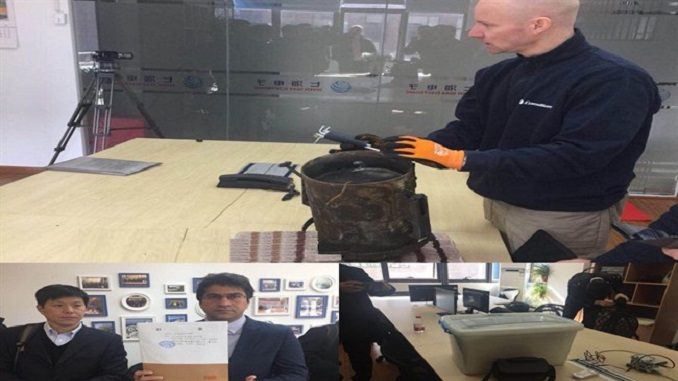
The black box of the Iranian sunken oil tanker “Sanchi” and the freighter CF Crystal, the two vessels that collided in the worst oil ship disaster in decades, has been opened in the presence of representatives from the involved countries on Wednesday, Iran consul general to Shanghai said according to Iran Daily.
Officials from China, Iran, and Panama were present when the black boxes were opened, Hadi Haqshenas, maritime affairs deputy at Iran’s Ports and Maritime Organization, was quoted as saying by ISNA. The report did not say where that happened. According to him, clarifying the ultimate results of the deciphering process takes time and it could take months.
“After opening the black box, the data inside it will be decrypted and delivered to the relevant sides. The analyzing procedure will take time and will have to be carried out with accuracy,” Alireza Irvash told IRNA on Wednesday.
Commenting on the transfer of the bodies of 3 sailors who lost their lives in the incident and their bodies have been found, Irvash said the required DNA tests are being done on them and their families in Iran.
“If there is no problem in identifying the bodies, they will be transferred to Iran in less than 10 days,” he said.
A sum of 30 Iranian and two Bangladeshi sailors, who were all crew members of the Sanchi crew, were killed because of the toxic gases and the huge fire which embraced the tanker after the ship collided with a Chinese freighter in the East China Sea on Jan 6. All the rescue efforts were in vain and the oil tanker sank on January 14.
The Sanchi, run by Iran’s top oil shipping operator, collided with the CF Crystal about 160 nautical miles off the coast of China near Shanghai and the mouth of the Yangtze River Delta on January 6. The Panama-registered tanker was sailing from Iran to South Korea, carrying 136,000 tonnes of condensate, an ultra-light crude, equivalent to just under 1 million barrels, worth about $60 million.
Oil from the Iranian tanker that sank in the East China Sea has diffused into four separate slicks, covering a combined area of just over 100 square km, Chinese authorities said late on Wednesday. Earlier satellite imaging showed two large slicks, with the larger one also thicker and more concentrated, but the latest data had found four slicks ranging in size from 48 square km to 5.5 square km, the State Oceanic Administration (SOA) said.
The SOA said in its statement late on Wednesday it had collected water samples from 19 spill sites and found water from five sites had petroleum substances at levels exceeding standards. Clean-up teams were continuing to monitor the wreck area to assess the drift and diffusion of the oil spill and the ecological impact.
One of the slicks, about 18 km in length and 300 meters wide, was found about 11 km north of the sunken tanker, and another, about 20 km long and about 500 meters wide, was found 2 km southwest of the wreck, it said.
The oil spill from an Iranian oil tanker is now the size of Paris. The slick covers an area of 101 square kilometers, after almost doubling in size from the start of the week, according to figures released Wednesday by the Chinese State Oceanic Administration. Chinese authorities said there were four separate slicks that had formed after the Panama-registered Sanchi tanker sank Sunday. The largest oil slick is 48 square kilometers, it added. The administration did not respond Thursday to a request for additional information.
Environmentalists and officials are worried the oil on board and fuel used to power the massive vessel could harm aquatic life for decades.
“The critical thing is to understand that when we put hydrocarbons into the oceans through events like this, it’s going to affect a wide range of animals,” said Jessica Meeuwig, a professor of biological sciences at the University of Western Australia.
The collision site was within the Zhoushan shipping ground, considered to be one of the richest fishing grounds in China, Ma Jun, one of China’s leading environmentalists said.
“If the oil spill is large, it could wipe out some fish species that are sensitive to the toxicity of the condensate. This is not what has been spilled in the past — it’s particularly unnerving because we don’t know what it will do to the environment. Sanchi might be one of the last straws before the ecosystem collapses,” Li Zhengyan, a professor with the college of environmental science and engineering at the Ocean University of China in Qingdao, told the South China Morning Post.
Condensate, which is made up of a mixture of hydrocarbons, is lighter than the thick black crude oil associated with some of the world’s worst oil spills, such as the Exxon Valdez disaster. Then, 11 million gallons of crude oil poured into the ocean when the tanker ran aground off Alaska in 1989.
